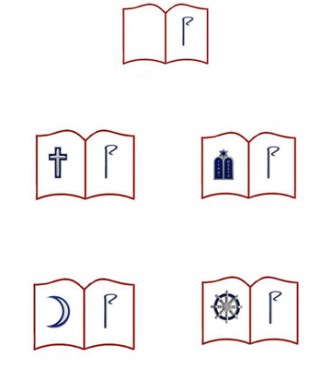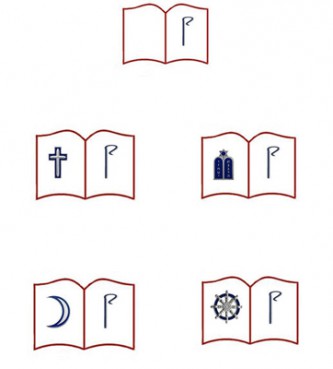
(RNS4-SEPT08) One proposal for redesigned uniform badges for military chaplains, composed by retired chaplain Rabbi Arnold Resnicoff, would feature specific religious symbols for different faiths on an open book with a shepherd’s crook. For use with RNS-CHAPLAIN-BADGE, transmitted Sept. 8, 2011. RNS photo courtesy Arnold Resnicoff.

(RNS4-SEPT08) One proposal for redesigned uniform badges for military chaplains, composed by retired chaplain Rabbi Arnold Resnicoff, would feature specific religious symbols for different faiths on an open book with a shepherd’s crook. For use with RNS-CHAPLAIN-BADGE, transmitted Sept. 8, 2011. RNS photo courtesy Arnold Resnicoff.
WASHINGTON (RNS) With a cross on his lapel, it’s easy to spot a military chaplain in uniform. But the same might not be true if the chaplain’s badge displays a prayer wheel, a crescent moon or tiny Torah scrolls.
And when the sole, newly commissioned Hindu chaplain starts wearing her symbol — which is still in the design stage — how many will recognize it as the sign of a chaplain?
Not many, said Rabbi Arnold Resnicoff, a retired military chaplain who served as command chaplain for the U.S. European Command.
“Military personnel will not identify symbols for chaplains if so few people wear them,” he said. “We need a universal insignia that automatically symbolizes the presence of a chaplain.”
Resnicoff welcomes the prospect of an even more diverse military chaplaincy in the future, but that’s likely only to worsen the problem of unfamiliar insignias.
His solution is a revamped chaplain’s insignia, which includes one element that is the same for all chaplains alongside a separate symbol that indicates a chaplain’s particular faith.
“A priest is still a priest. A rabbi is still a rabbi. A minister is still a minister,” Resnicoff said.
Unlike military chaplains in other countries who often minister only to members of their own faith groups, American chaplains provide spiritual guidance to members of their own flock, those of other faiths and service members who profess no religion.
Currently thousands of Christian clergy and dozens of clergy of other faiths serve as active-duty chaplains in the U.S. military.
When he was a military chaplain, Resnicoff said he was often asked what the Torah scrolls on his uniform meant. Maj. Ibraheem Raheem, a Muslim Army chaplain, has joked that soldiers who see the crescent moon on his uniform sometimes ask him if he is an astronaut.
Top brass at the Pentagon have endorsed Resnicoff’s idea of a universal-yet-denominational insignia, if not his actual sketches.
“I like the idea of developing a new chaplain insignia that represents both the unity and diversity of the chaplain corps,” said Major Gen. Cecil Richardson, chairman of the Armed Forces Chaplains Board.
As the Army prepares to welcome its first Hindu chaplain, “the time is right to look at the bigger issue of chaplain insignia across the services,” he said.
For the universal clergy symbol, Resnicoff envisions an open book, with a shepherd’s crook on one of the pages. The crook, the original symbol of U.S. Army chaplains, adorned the uniform from 1880 to 1888, and conveys the idea of a chaplain as a tender of the flock.
On the other page of the book, Resnicoff would place the symbol of the individual chaplain’s religion. There are already competing ideas.
The National Conference on Ministry to the Armed Forces, the largest umbrella group of organizations that endorse chaplain candidates for military service, supports Resnicoff’s idea in principle.
Last month, it presented two other possible designs for Richardson’s board to consider: a circle and a shield. Designed by retired Chaplain Lyman Smith, either would serve as a background for the particular religious symbol.
Smith, a Presbyterian, wrote in support of his design: “The concept of a shield is not necessarily foreign to any faith tradition but also does not play a major role for any faith group.”
Resnicoff said he’s partial to the shepherd’s crook because of its history with the military, but would welcome any design that encompasses the chaplains’ dual missions to serve both followers of their own traditions and any others who seek spiritual counseling.
Richardson has asked an advisory committee to collect proposals for a new insignia and to make a recommendation to his board. The final decision will be made in the Office of the Secretary of Defense.




